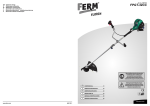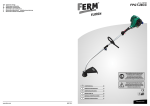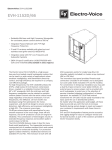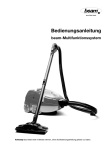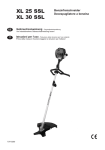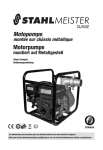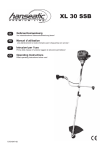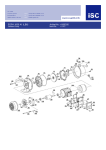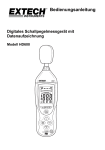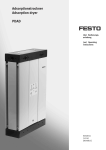Download FBLB 33 A1 (LB3) Artikel-Nr.: 3436062
Transcript
FBLB 33 A1 (LB3) Artikel-Nr.: 3436062 Petrol Shoulder Blower Ident-Nr.: 11012 Komponenten / Ersatzteile Position Artikel-Nr. Beschreibung 1 343604001001 M6 Nut M6 2 343604001002 Washer 6 3 343604001003 Tragegurt 4 343604001004 Blower Pipe C2 9 343606001009 Fan guard (Green Pantone 361) für Lüfterrad (Florabest) 10 343604001010 Shock Absorption 12 343606001012 Rear fan cover (Pantone 361) Florabest 16 343604001016 Flywheel 18 343606001018 Front fan cover (Pantone 361) Florabest 21 343604001021 washer 22 343604001022 locknut M6 23 343606001023 Shield (Green Pantone 361) Florabest 24 343604001024 Seilzugstarter 26 343604001026 Bend Pipe 28 343604001028 Hose 29 343604001029 Blower Pipe A 30 343604001030 Blower Pipe B 31 343604001031 Blower Pipe C1 34 343606001034 Left control handle (Pant.361) Florabest 37 343606001037 Stop switch (Red RAL 3001) (Rot) 42 343606001042 Right control handle(Pant.361) Florabest 43 343606001043 Throttle lever (RAL 3001) (Rot) 44 343606001044 Retainer lever (RAL 3001) (Rot) 50 343604001050 Throttle wire 51 343604001051 Threaded pipe 10 52 343604001052 Lead wire 56 343604001056 American hose clip 58 343606001058 engine 0,9 KW/1,22 PS;33 ccm (Florab. 0 343604001059 accessory engine Artikel-Nr.: 343604001058 0,9 KW / 1,22 PS; 33 ccm Ident-Nr.: Komponenten / Ersatzteile Position Artikel-Nr. Beschreibung 3 343604001103 Rotor 4 343604001104 Spark plug RCJ6Y 7 343604001107 Cylinder 8 343604001108 Gasket,cylinder 9 343604001109 Ring,piston 10 343604001110 Piston 11 343604001111 Pin,piston 9X31 12 343604001112 Ring, snap 17 343604001117 Gasket,crankcase 21 343604001121 Starter pulley comp 22 343604001122 Clip , pipe für Benzinfilter 23 343604001123 Fuel filter comp 31 343604001131 Muffler assy 32 343604001132 Heat shield 33 343604001133 Bolt M5X55 M5 x 55 37 343604001137 Ignition coil comp 42 343604001142 Fule tank 43 343604001143 Chock handle 46 343604001146 Gasket,insulator 49 343604001149 Gasket,carburetor 50 343604001150 Carburetor comp 51 343604001151 Gasket,carburetor 53 343604001153 Pipe 56 343604001156 choke 57 343604001157 Base, cleaner für Luftfilter 58 343604001158 Primer pump assy 59 343604001159 Air filter element 60 343604001160 Bolt assy M5X60 M5 x 60 61 343604001161 Cover, cleaner 62 343604001162 Knob,cover M4 x 32 901 343604001901 fuel tank cap Petrol Leaf Blower FBLB 33 A1 KO Petrol Leaf Blower FAC Benzin-Laubbläser Operation and Safety Notes Original operating instructions Bedienungs- und Sicherheitshinweise Originalbetriebsanleitung IAN 76160 Anleitung_3436062_LB3.indb 1 KO 01.06.12 12:52 KO Before reading, unfold the page containing the illustrations and familiarise yourself with all functions of the device. FAC Klappen Sie vor dem Lesen die Seite mit den Abbildungen aus und machen Sie sich anschließend mit allen Funktionen des Gerätes vertraut. GB/IE Operation and Safety Notes Page 7 DE/AT/CH Bedienungs- und Sicherheitshinweise Seite 17 -2- Anleitung_3436062_LB3.indb 2 01.06.12 12:52 1 1 2 3 4 20 5 6 19 7 10 18 16 9 8 15 17 11 14 13 2 12 2a 12 A -3- Anleitung_3436062_LB3.indb 3 01.06.12 12:52 2b 2c 13 D C 1 1 12 3 B 13 3a 12 13 14 E 4a 2 3 4 4b 1 7 8 10 -4- Anleitung_3436062_LB3.indb 4 01.06.12 12:53 5 6 7a 7b 8a 8b -5- Anleitung_3436062_LB3.indb 5 01.06.12 12:53 9 1 2 3 4 6 7 8 9 5 -6- Anleitung_3436062_LB3.indb 6 01.06.12 12:53 GB/IE Table of contents 1. 2. 3. 4. 5. 6. 7. 8. Introduction.................................................................................................................................................. 8 Safety regulations ....................................................................................................................................... 8 Layout and items supplied .......................................................................................................................... 9 Proper use ..................................................................................................................................................10 Technical data ...........................................................................................................................................10 Before starting the equipment ..................................................................................................................10 Operation ...................................................................................................................................................11 Cleaning, maintenance, storage, starting again after storage, transport and ordering of spare parts ..................................................................................................... 12 9. Disposal and recycling ............................................................................................................................. 13 10. Troubleshooting guide .............................................................................................................................. 14 11. Declaration of conformity......................................................................................................................... 15 12. Warranty certificate .................................................................................................................................. 16 The reprinting or reproduction by any other means, in whole or in part, of documentation and papers accompanying products is permitted only with the express consent of the iSC GmbH. Subject to technical changes -7- Anleitung_3436062_LB3.indb 7 01.06.12 12:53 GB/IE 1. Introduction shoes, strong gloves, a safety helmet, a face mask, safety goggles to protect your eyes and ear plugs or similar to protect your hearing. 2. Fill in fuel in a safe place. Open the fuel tank cap carefully so that any existing pressure can escape slowly and no fuel splashes out. Before starting the engine, clean the equipment of any fuel or oil residues. Start the engine at least 3m away from the fueling point. 3. Always switch off the engine when put the equipment down and before you carry out any work on the equipment. 4. Check that all the screws and fasteners are secure. The equipment may be used only when it is safe to operate. Never use the equipment if it has not been properly adjusted or has not been fully or safely assembled. 5. Keep the handles dry, clean and free of fuel mix. 6. Store the equipment and accessories in a safe place protected from naked flames and heat/ spark sources such as gas geyser heaters, tumble driers, oil stoves or portable radiators, etc. 7. Keep the engine free of dirt. 8. Only adequately trained people and adults may use, adjust and maintain the equipment. 9. A high-quality dust mask must always be worn by users with breathing problems and by everyone who works with the equipment in a very dusty environment . Paper dust masks are available from general stores where you can buy paint and household goods. 10. Use the equipment only at reasonable times of the day. Do not use early in the morning or late in the evening when people could feel disturbed. Pay attention to your local noise control regulations. 11. Allow the equipment to run at the lowest possible engine speed required to carry out the work. 12. Before you start work, use a brush and scraper to remove all dirt from the equipment. 13. In case of dusty conditions, moisten the surface a little. 14. Use the full-length blower nozzle extension so that the air current can work near to the ground. Congratulations on your new purchase. You have decided in favor of a high-quality product. The operating instructions are a part of this product. They contain information of importance for your safety, for the use of the product and for its disposal. Before you use the product, acquaint yourself with all the information concerning its operation and safety. Use the product only as described and only for the listed areas of application. If you hand on the product to other people, give them all the documentation as well. 2. Safety regulations Caution! Read all safety regulations and instructions. Any errors made in following the safety regulations and instructions may result in an electric shock, fire and/or serious injury. Keep all safety regulations and instructions in a safe place for future use. Explanation of the warning signs on the equipment (see Fig. 9) 1. Read the operating instructions before you use the equipment. 2. Wear safety goggles to protect your eyes Wear ear plugs to protect yourself from the noise. 3. Warning! Hazard! 4. Keep other people away! 5. Warning! Hot surface 6. Fuel pump 7. Never work if people – especially children or animals are in the danger area. 8. Sound power level with EC Directive 2000/14/EC. 9. After the unit is switched off, the motor continues to run for a short while. 1. Wear tight-fitting, sturdy work clothes/ protective clothes, which should be practical and must not impede your movements (long trousers or overalls). Wear also safety work -8- Anleitung_3436062_LB3.indb 8 01.06.12 12:53 GB/IE 3. Layout and items supplied 15. Watch out for children, pets, open windows etc. and blow the dirt safely away from them. 16. Do not smoke while refueling or using the equipment. 17. Never use the equipment without a silencer and a correctly installed exhaust guard. 18. Keep your hands and other parts of the body away from the exhaust pipe and the ignition cable. 19. The equipment produces toxic exhaust fumes as soon as the engine is started. Never work in enclosed rooms or in rooms with poor ventilation. 20. Never blow in the direction of other persons, animals, buildings, vehicles or windows, etc. ! The equipment can throw up small objects at high velocity. 21. To prevent contact with the blower, never operate the equipment without the blower tube guard. 22. Do not put down the hot engine near inflammable objects/ materials. 23. Do not use the equipment over a lengthy period of time, take regular breaks. 24. Never use the equipment when under the influence of alcohol or drugs. WARNING: Modifying the equipment and adding parts or removing parts may place your personal safety at risk and cause the manufacturer’s warranty to be voided. 25. Never use the equipment near inflammable liquids or gases, whether in enclosed rooms or outdoors. Explosions and/or fire may result. 26. Do not wear any clothing, scarves, neck-ties or jewelry which could get into the air intake opening. Tie up and secure long hair (e.g. with a head-scarf, cap, helmet, etc.). 27. Never refuel when the engine is running or hot. 28. Never allow children under 14 years of age to use the equipment. 3.1 Layout (Fig. 1) 1. Handle 2. Throttle lever 3. Throttle lever catch 4. On/Off switch 5. Spark boot plug 6. Air filter cover 7. Choke lever 8. Starter handle (starter cable) 9. Petrol tank 10. Fuel pump (primer) 11. Engine unit 12. Flexible blower hose 13. Top blower tube 14. Bottom blower tube 15. Blower nozzle (large opening) 16. Blower nozzle (small opening) 17. Spark plug wrench 18. Petrol/ oil mix bottle 19. Hexagonal wrench 20. Open-ended wrench 3.2 Items supplied • Open the packaging and take out the equipment with care. • Remove the packaging material and any packaging and/or transportation braces (if available). • Check to see if all items are supplied. • Inspect the equipment and accessories for transport damage. • If possible, please keep the packaging until the end of the guarantee period. Important! The equipment and packaging material are not toys. Do not let children play with plastic bags, foils or small parts. There is a danger of swallowing or suffocating! Keep this safety information in a safe place. -9- Anleitung_3436062_LB3.indb 9 01.06.12 12:53 GB/IE 4. Proper use Sound and vibration values were measured in accordance with 2000/14/EC. This equipment is designed for cleaning walkways, drives and other paths. Any other use, e.g. inflating objects, is not permitted. Sound and vibration values were measured at the highest speed. The equipment may be used only for its intended purpose. Any other use is deemed to be a case of misuse. The user/operator and not the manufacturer will be liable for any damage or injuries of any kind resulting from such misuse. Please note that our equipment has not been designed for use in commercial, trade or industrial applications. Our warranty will be voided if the equipment is used in commercial, trade or industrial businesses or for equivalent purposes. 5. Technical data Engine type ............... 2-stroke engine; air-cooled Engine power (max.) ..................0.9 kW/ 1.22 hp Displacement ............................................... 33 ccm Max. engine speed ..............................8500 min-1 Ignition ...................................................... Electronic Weight (with empty tank) .............................6.3 kg Tank capacity .............................................. 650 ml Spark plug .................................................... RCJ6Y Maximum air speed ...............................250 km/h Sound and vibration LpA sound pressure level ........................... 97 dB(A) KpA uncertainty ............................................. 1.5 dB LWA sound power level ........................... 111 dB(A) KWA uncertainty ............................................ 1.5 dB Wear ear-muffs. The impact of noise can cause damage to hearing. Operation Vibration emission value ah = 3.87 m/s2 K uncertainty = 1.5 m/s2 Keep the noise emissions and vibrations to a minimum. • Only use appliances which are in perfect working order. • Service and clean the appliance regularly. • Adapt your working style to suit the appliance. • Do not overload the appliance. • Have the appliance serviced whenever necessary. • Switch the appliance off when it is not in use. • Wear protective gloves. 6. Before starting the equipment 6.1 Fitting the blower tube (Fig. 2-3) The equipment must be assembled as follows before it is put into operation. • Before the equipment is used for the first time, the cardboard transport guard must be removed as shown in Figure 2. • Push the flexible blower hose (Fig. 2a/ Item 12) over the connection on the engine unit and tighten the hose clip (Fig. 2a/Item A). • Now push the handle (Fig. 2b/Item 1) over the top blower tube (Fig. 2b/Item. 13). • Align the handle (Fig. 2c/Item 1) and the stop (Fig. 2c/Item B) as shown in Figure 2c and screw the handle tight. • Move the flexible ring (Fig. 2c/Item C) into center position so that its distance from the stop B is the same when rotated to the left and to the right. • Now push the top blower tube (Fig. 2c/ Item 13) into the flexible blower hose (Fig. 2c/ Item 12) and secure with the hose clip (Fig. 2c/Item D). • Use the long clip (Fig. 3/Item E) to secure the cable conduit to the flexible blower hose (Fig. 3/Item 12). - 10 - Anleitung_3436062_LB3.indb 10 01.06.12 12:53 GB/IE • Push the bottom blower tube (Fig. 3a/ Item • handle. 6. Pull the starter cable (8) out a short way until you feel resistance. It must be pulled evenly and quickly to start the engine. When the engine is running, set the choke lever to „ „. 7. Allow the engine to warm up for approx. 10 seconds. Note: If the engine fails to start after repeated attempts, proceed as described in the section „Troubleshooting guide“. 14) over the top blower tube (Fig. 3a/Item 13) and lock by turning clockwise. The blower nozzle with either the large or small opening can be fitted. Push the blower nozzles over the blower tube and lock by turning clockwise. 6.2 Fuel and oil Use only a mixture of unleaded petrol and special 2-stroke engine oil. Mix the fuel mixture as indicated in the fuel mixing table. Important: Do not use a fuel mixture which has been stored for longer than 90 days. Important: Never use 2-stroke oil with a recommended mixing ratio of 100:1. The manufacturer’s warranty will be voided in case of engine damage due to inadequate lubrication. Important: Only use containers designed and approved for the purpose to transport and store fuel. Pour the correct quantities of petrol and 2-stroke oil into the attached mixing bottle (see scale printed on the bottle). Then shake the bottle well. Note: Always pull out the starter cable in a straight line. If it is pulled out at an angle, the cable will rub against the eyelet. This friction will cause fraying and therefore greater wear on the starter cable. Always hold the starter handle securely when the cable is retracted. Take care not to let the cable snap back after it has been pulled out. This could cause the cable to catch/become worn and/or might damage the starter housing. 7.2 Warm starts (engine off for no longer than 15- 20 minutes) 1. Set the On/Off switch (Figure 1 / Item 4) to „ON“ and pull the starter cable (Fig. 1/Item 8). The engine should start after one or two pulls. If the engine does not start after 6 pulls, repeat steps 2 to 6 (see the section „Cold starts“). 2. If the engine fails to start, or if it starts and stops again after several pulls, follow the instructions in the section „Cold starts“. 6.3 Fuel mixture table Mixing procedure: 40 parts petrol to 1 part oil Petrol 2-stroke oil 1 liter 25 ml 5 liters 125 ml 7.3 Switching off the engine Emergency Stop procedure: If it becomes necessary to stop the blower immediately (in an emergency), set the ignition switch (Fig. 1/Item 4) to „OFF“. 7. Operation Please note that the statutory regulations governing noise abatement may differ from one location to another. Normal procedure: To switch off the engine, push back the throttle lever catch so that the engine runs in idle mode. Then move the On/Off switch (Fig. 1/Pos. 4) to „OFF“. 7.1 Cold starts (4a-4b) Fill the tank with the required amount of oil/petrol mix. See also „Fuel and oil“. 1. Place the equipment safely and securely on the ground. 2. Set the On/Off switch (4) to „ON“ (Fig. 4a) 3. Press the fuel pump (10) (Fig. 4b) 10 times. 4. Set the choke lever (7) to „ „. 5. Hold the equipment firmly by the holding - 11 - Anleitung_3436062_LB3.indb 11 01.06.12 12:53 GB/IE 7.4 Blower mode Your leaf blower is designed for blow-cleaning terraces, walkways, lawns, shrubs and many hard-to-reach areas where dirt and debris can collect. For your own personal safety, please read again all the safety information and directions for use in these operating instructions before you operate the equipment. Do not use the equipment if other people or animals are in the immediate vicinity. Keep a minimum distance of 10m from other persons or animals. When working in a very dusty environment, wear a dust mask or breathing mask. For better control of the blowing direction, always keep a suitable distance from the material you want to blow away. Never blow in the direction of persons in the immediate vicinity. Before you use the equipment, use a rake or broom to dislodge and remove foreign bodies from the area you want to clean. This will help to prevent injuries. Control the air velocity by adjusting the throttle lever between the idle and full throttle settings. Test different throttle lever settings in order to find the optimum air velocity for the particular task. Important: Always wear safety goggles or a face mask for protection against objects which are whirled up or catapulted away. Important: Always carry the equipment so that the hot exhaust gases do not come into contact with your clothes and damage them and so that the fumes are not inhaled. To operate the equipment: Follow the instructions for starting the engine as described in section 7.1 and 7.2. Let the engine run in idle mode and put on the equipment as shown in Fig. 5. Make sure that nothing covers the exhaust pipe as it becomes hot. Hold the handle tightly in your right hand (Fig. 6) and swing the blower tube back and forth so that the required area is cleared of dirt and debris. Integrated in the handle (Fig. 4a/Item 1) are the throttle lever (Fig. 4a/Item 2) and the On/Off switch (Fig. 4a/Item 4). The throttle lever catch (Fig. 4a/Item 3) can be used to lock the engine in the full throttle setting without having to keep pressing the throttle lever. Important: Before you switch off the equipment, reset the throttle lever catch to the standard throttle setting. 8. Cleaning, maintenance, storage, starting again after storage, transport and ordering of spare parts Always switch off the equipment and pull out the spark plug boot before carrying out any maintenance work. 8.1 Cleaning • Keep all safety devices, air vents and the motor housing free of dirt and dust as far as possible. Wipe the equipment with a clean cloth or blow it down with compressed air at low pressure. • We recommend that you clean the equipment immediately after you use it. • Clean the equipment regularly with a damp cloth and some soft soap. Do not use cleaning agents or solvents; these may be aggressive to the plastic parts in the equipment. Ensure that no water can get into the interior of the equipment. 8.2 Maintenance Servicing the air filter (Fig. 7a-7b) Soiled air filters reduce the engine output by supplying too little air to the carburetor. Regular checks are therefore essential. The air filter should be checked after every 25 hours of use and cleaned if necessary. If the air contains a lot of dust, the air filter should be checked more frequently. 1. Remove the air filter cover (Fig. 7a). 2. Remove the filter element (Fig. 7b). 3. Clean the filter element by tapping it or blowing it. 4. Assemble in reverse order. Important: Never clean the air filter with petrol or inflammable solvents. - 12 - Anleitung_3436062_LB3.indb 12 01.06.12 12:53 GB/IE 8.4 Starting again after storage 1. Remove the spark plug. 2. Pull the starter cable several times to clean the oil residue out of the combustion chamber. 3. Clean the spark plug contacts or fit a new spark plug. 4. Fill the tank. See the section “Fuel and oil”. 5. Complete steps 1-7 described in the section “Cold starts”. Servicing the spark plug (Fig. 8a-8b) Spark plug sparking gap = 0.6 mm. Tighten the spark plug with a torque of 12 to 15 Nm. Check the spark plug for dirt and grime after 10 hours of operation and if necessary clean it with a copper wire brush. Thereafter service the spark plug after every 50 hours of operation. 1. Pull off the spark plug boot (Fig. 8a) by twisting. 2. Remove the spark plug (Fig. 8b) with the supplied spark plug wrench. 3. Assemble in reverse order. 8.3 Storage Important: If you fail to follow these instructions correctly, deposits may form on the interior of the carburetor which may result in the engine being more difficult to start or the equipment suffering permanent damage. 1. Carry out all the general maintenance work that is described in the section “Maintenance” in the operating instructions. 2. Drain the fuel out of the tank (use a conventional plastic petrol pump for this purpose). 3. When the fuel has been drained, start the equipment. 4. Allow the equipment to run at idling speed until it stops. This will clean the remainder of the fuel out of the carburetor. 5. Let the equipment cool down. (approx. 5 minutes) 6. Remove the spark plug. 7. Place a teaspoon full of 2-stroke engine oil into the combustion chamber. Pull the starter cable several times carefully to wet the internal components with the oil. Fit the spark plug again. 8. Clean the exterior housing of the equipment. 9. Store the equipment in a cold, dry place where it is out of the reach of ignition sources and inflammable substances. Fertilizers and other chemical garden products often contain substances that accelerate the rate of corrosion of metals. Do not store the equipment on or near fertilizers or other chemicals. 8.5 Transport To transport the equipment, empty the petrol tank as described in the section “Storage”. Clean coarse dirt off the equipment with a brush or hand brush. 8.6 Ordering spare parts Please provide the following information on all orders for spare parts: • Model/type of the equipment • Article number of the equipment • ID number of the equipment For our latest prices and information please go to: www.isc-gmbh.info 9. Disposal and recycling The unit is supplied in packaging to prevent its being damaged in transit. This packaging is raw material and can therefore be reused or can be returned to the raw material system. The unit and its accessories are made of various types of material, such as metal and plastic. Defective components must be disposed of as special waste. Ask your dealer or your local council. - 13 - Anleitung_3436062_LB3.indb 13 01.06.12 12:53 GB/IE 10.Troubleshooting guide Fault Possible cause Remedy The equipment does not start. - Correct starting procedure not follo- - Follow the instructions for starting. wed. - Sooted or damp spark plug. - Clean the spark plug or replace it with a new one (see section 8.2). - Incorrect carburetor setting. - Contact an authorized customer service outlet or send the equipment to ISC GmbH. The equipment starts but does not develop its full power. - Incorrect choke lever setting. The engine does not run smoothly. - Incorrect electrode gap on the spark plug. - Soiled air filter. - Incorrect carburetor setting. - Incorrect carburetor setting. Engine smokes excessively. - Incorrect fuel mix. - Incorrect carburetor setting. - Set the choke lever (Fig. 1/Item 7) to “ ”. - Clean the air filter (see section 8.2). - Contact an authorized customer service outlet or send the equipment to ISC GmbH. - Clean the spark plug and adjust the electrode gap, or fit a new spark plug (see section 8.2). - Contact an authorized customer service outlet or send the equipment to ISC GmbH. - Use the correct fuel mix (see the fuel mixing table). - Contact an authorized customer service outlet or send the equipment to ISC GmbH. - 14 - Anleitung_3436062_LB3.indb 14 01.06.12 12:53 GB/IE 11. Declaration of conformity Einhell Germany AG · Wiesenweg 22 · D-94405 Landau/Isar Konformitätserklärung D erklärt folgende Konformität gemäß EU-Richtlinie und Normen für Artikel GB explains the following conformity according to EU directives and norms for the following product F déclare la conformité suivante selon la directive CE et les normes concernant l’article I dichiara la seguente conformità secondo la direttiva UE e le norme per l’articolo NL verklaart de volgende overeenstemming conform EU richtlijn en normen voor het product E declara la siguiente conformidad a tenor de la directiva y normas de la UE para el artículo P declara a seguinte conformidade, de acordo com a directiva CE e normas para o artigo DK attesterer følgende overensstemmelse i medfør af EU-direktiv samt standarder for artikel S förklarar följande överensstämmelse enl. EU-direktiv och standarder för artikeln FIN vakuuttaa, että tuote täyttää EU-direktiivin ja standardien vaatimukset EE tõendab toote vastavust EL direktiivile ja standarditele CZ vydává následující prohlášení o shodě podle směrnice EU a norem pro výrobek SLO potrjuje sledečo skladnost s smernico EU in standardi za izdelek SK vydáva nasledujúce prehlásenie o zhode podľa smernice EÚ a noriem pre výrobok H a cikkekhez az EU-irányvonal és Normák szerint a következő konformitást jelenti ki PL deklaruje zgodność wymienionego poniżej artykułu z następującymi normami na podstawie dyrektywy WE. BG декларира съответното съответствие съгласно Директива на ЕС и норми за артикул LV paskaidro šādu atbilstību ES direktīvai un standartiem LT apibūdina šį atitikimą EU reikalavimams ir prekės normoms RO declară următoarea conformitate conform directivei UE şi normelor pentru articolul GR δηλώνει την ακόλουθη συμμόρφωση σύμφωνα με την Οδηγία ΕΚ και τα πρότυπα για το προϊόν HR potvrđuje sljedeću usklađenost prema smjernicama EU i normama za artikl Izjava o sukladnosti za ovaj proizvod dostupna je na internet stranici www.lidl.hr. BIH potvrđuje sljedeću usklađenost prema smjernicama EU i normama za artikl RS potvrđuje sledeću usklađenost prema smernicama EZ i normama za artikal RUS следующим удостоверяется, что следующие продукты соответствуют директивам и нормам ЕС UKR проголошує про зазначену нижче відповідність виробу директивам та стандартам ЄС на виріб MK ја изјавува следната сообрзност согласно ЕУ-директивата и нормите за артикли TR Ürünü ile ilgili AB direktifleri ve normları gereğince aşağıda açıklanan uygunluğu belirtir N erklærer følgende samsvar i henhold til EU-direktivet og standarder for artikkel IS Lýsir uppfyllingu EU-reglna og annarra staðla vöru Benzin-Rückenlaubbläser FBLB 33 A1 (Florabest) 87/404/EC_2009/105/EC X 2006/42/EC Annex IV 2005/32/EC_2009/125/EC Notified Body: Notified Body No.: Reg. No.: 2006/95/EC 2006/28/EC X 2000/14/EC_2005/88/EC X Annex V X 2004/108/EC 2004/22/EC Annex VI 1999/5/EC Noise measured: LWA = 107 dB (A); guaranteed LWA = 111 dB (A) P = 0,9 KW; L/Ø = cm Notified Body: 97/23/EC 90/396/EC_2009/142/EC X 2006/28/EC Emission No.: e11*97/68SA*2004/26*0643*00 89/686/EC_96/58/EC 2011/65/EC Standard references: EN 15503; EN 14982 Landau/Isar, den 24.05.2012 Weichselgartner/General-Manager First CE: 12 Art.-No.: 34.360.62 I.-No.: 11012 Subject to change without notice Sun/Product-Management Archive-File/Record: NAPR005898 Documents registrar: Robert Mayn Wiesenweg 22, D-94405 Landau/Isar - 15 - Anleitung_3436062_LB3.indb 15 01.06.12 12:53 GB/IE 12. Warranty certificate Dear Customer, All of our products undergo strict quality checks to ensure that they reach you in perfect condition. In the unlikely event that your device develops a fault, please contact our service department at the address shown on this guarantee card. Of course, if you would prefer to call us then we are also happy to offer our assistance under the service number printed below. Please note the following terms under which guarantee claims can be made: 1. These guarantee terms cover additional guarantee rights and do not affect your statutory warranty rights. We do not charge you for this guarantee. 2. Our guarantee only covers problems caused by material or manufacturing defects, and it is restricted to the rectification of these defects or replacement of the device. Please note that our devices have not been designed for use in commercial, trade or industrial applications. Consequently, the guarantee is invalidated if the equipment is used in commercial, trade or industrial applications or for other equivalent activities. The following are also excluded from our guarantee: compensation for transport damage, damage caused by failure to comply with the installation/assembly instructions or damage caused by unprofessional installation, failure to comply with the operating instructions (e.g. connection to the wrong mains voltage or current type), misuse or inappropriate use (such as overloading of the device or use of non-approved tools or accessories), failure to comply with the maintenance and safety regulations, ingress of foreign bodies into the device (e.g. sand, stones or dust), effects of force or external influences (e.g. damage caused by the device being dropped) and normal wear resulting from proper operation of the device. This applies in particular to rechargeable batteries for which we nevertheless issue a guarantee period of 12 months. The guarantee is rendered null and void if any attempt is made to tamper with the device. 3. The guarantee is valid for a period of 3 years starting from the purchase date of the device. Guarantee claims should be submitted before the end of the guarantee period within two weeks of the defect being noticed. No guarantee claims will be accepted after the end of the guarantee period. The original guarantee period remains applicable to the device even if repairs are carried out or parts are replaced. In such cases, the work performed or parts fitted will not result in an extension of the guarantee period, and no new guarantee will become active for the work performed or parts fitted. This also applies when an on-site service is used. 4. In order to assert your guarantee claim, please send your defective device postage-free to the address shown below. Please enclose either the original or a copy of your sales receipt or another dated proof of purchase. Please keep your sales receipt in a safe place, as it is your proof of purchase. It would help us if you could describe the nature of the problem in as much detail as possible. If the defect is covered by our guarantee then your device will either be repaired immediately and returned to you, or we will send you a new device. Of course, we are also happy offer a chargeable repair service for any defects which are not covered by the scope of this guarantee or for units which are no longer covered. To take advantage of this service, please send the device to our service address. Einhell UK Ltd Morpeth Wharf Twelve Quays Birkenhead, Wirral CH41 1LF Tel. 0151 6491500, Fax 0151 6491501 IAN 76160 - 16 - Anleitung_3436062_LB3.indb 16 01.06.12 12:53 DE/AT/CH Inhaltsverzeichnis 1. Einleitung ................................................................................................................................................... 18 2. Sicherheitshinweise .................................................................................................................................. 18 3. Gerätebeschreibung und Lieferumfang .................................................................................................. 19 4. Bestimmungsgemäße Verwendung .........................................................................................................20 5. Technische Daten ......................................................................................................................................20 6. Vor Inbetriebnahme .................................................................................................................................. 21 7. Bedienung ................................................................................................................................................. 21 8. Reinigung, Wartung, Lagerung, Wiederinbetriebnahme, Transport und Ersatzteilbestellung ...........23 9. Entsorgung und Wiederverwertung ........................................................................................................24 10. Fehlersuchplan ..........................................................................................................................................25 11. Konformitätserklärung ..............................................................................................................................26 12. Garantieurkunde .......................................................................................................................................27 Der Nachdruck oder sonstige Vervielfältigung von Dokumentation und Begleitpapieren der Produkte, auch auszugsweise, ist nur mit ausdrücklicher Zustimmung der iSC GmbH zulässig. Technische Änderungen vorbehalten - 17 - Anleitung_3436062_LB3.indb 17 01.06.12 12:53 DE/AT/CH 1. Einleitung Herzlichen Glückwunsch zum Kauf Ihres neuen Gerätes. Sie haben sich damit für ein hochwertiges Produkt entschieden. Die Bedienungsanleitung ist Bestandteil dieses Produkts. Sie enthält wichtige Hinweise für Sicherheit, Gebrauch und Entsorgung. Machen Sie sich vor der Benutzung des Produkts mit allen Bedien- und Sicherheitshinweisen vertraut. Benutzen Sie das Produkt nur wie beschrieben und für die angegebenen Einsatzbereiche. Händigen Sie alle Unterlagen bei Weitergabe des Produkts an Dritte mit aus. 2. Sicherheitshinweise Warnung Lesen Sie alle Sicherheitshinweise und Anweisungen. Versäumnisse bei der Einhaltung der Sicherheitshinweise und Anweisungen können elektrischen Schlag, Brand und/oder schwere Verletzungen verursachen. Bewahren Sie alle Sicherheitshinweise und Anweisungen für die Zukunft auf. Erklärung der Hinweisschilder auf dem Gerät (siehe Bild 9) 1. Bedienungsanleitung vor Gebrauch des Gerätes lesen 2. Schutzbrille tragen, um Augen zu schützen Ohrschützer zum Schutz gegen Lärm tragen 3. Warnung! Gefahr! 4. Halten Sie Umstehende fern! 5. Warnung! Heisse Oberfläche 6. Kraftstoffpumpe 7. Arbeiten Sie nie, während Leute, besonders Kinder oder Tiere, sich im Gefahrenbereich aufhalten. 8. Schallleistungspegel entsprechend der Richtlinie 2000/14/EC. 9. Der Motor dreht nach Ausschalten des Gerätes noch nach. 1. Tragen Sie enganliegende, strapazierfähige Arbeitskleidung/ Sicherheitskleidung, diese sollte zweckmäßig sein und darf nicht behindern (lange Hose oder Kombianzug). Tragen Sie des Weiteren Sicherheitsarbeitsschuhe, feste Handschuhe, Schutzhelm, Gesichtsschutz und Schutzbrille zum Schutz der Augen und Gehörschutzstöpsel oder ähnlichen Gehörschutz. 2. Kraftstoff auffüllen an einem sicheren Ort. Tankverschluss vorsichtig öffnen, damit bestehender Überdruck sich langsam abbauen kann und kein Kraftstoff herausspritzt. Vor dem Starten des Motors säubern Sie das Motorgerät von eventuellen Kraftstoff- oder Ölrückständen. Starten Sie den Motor mindestens 3m vom Ort des Tankens entfernt. 3. Schalten Sie den Motor des Geräts stets aus, wenn Sie es abstellen und bevor Sie Arbeiten am Gerät durchführen. 4. Überprüfen Sie den festen Sitz aller Schrauben und Verschlüsse. Das Gerät darf nur in betriebsicherem Zustand benutzt werden. Benutzen Sie das Gerät niemals, wenn es nicht ordnungsgemäß eingestellt und komplett und sicher zusammengebaut ist. 5. Halten Sie die Griffe trocken, sauber und frei von Kraftstoffmischung. 6. Lagern Sie das Gerät und Zubehör sicher und geschützt vor offenen Flammen und Hitze-/ Funkenquellen, wie Gasdurchlauferhitzer, Wäschetrockner, Ölöfen oder tragbare Radiatoren, etc.. 7. Halten Sie den Motor frei von Schmutz. 8. Nur ausreichend geschulte Personen und Erwachsene dürfen das Gerät bedienen, einstellen und warten. 9. Bedienpersonal mit Atemwegsproblemen und Personen, die in einer sehr staubigen Umgebung arbeiten, sollten stets eine hochwertige Staubmaske tragen. Papierstaubmasken sind erhältlich in gängigen Farb- und Haushaltswarengeschäften. 10. Arbeiten Sie mit dem Gerät nur zu angemessenen Zeiten. Nicht früh morgens oder spät abends, wenn Leute gestört werden könnten. Beachten Sie die örtlichen Lärmschutzverordnungen. - 18 - Anleitung_3436062_LB3.indb 18 01.06.12 12:53 DE/AT/CH 11. Lassen Sie das Gerät mit der niedrigst möglichen Motordrehzahl laufen, um die Arbeit zu erledigen. 12. Befreien Sie das Gerät vor dem Arbeiten mit Besen und Kratzeisen vor Verunreinigungen. 13. Bei staubigen Bedingungen befeuchten Sie die Oberfläche etwas. 14. Verwenden Sie die volle Gebläsedüseverlängerung, so dass der Luftstrom nah am Boden arbeiten kann. 15. Schauen Sie nach Kindern, Haustieren, offenen Fenstern etc. und blasen Sie den Schmutz sicher weg. 16. Nicht rauchen, wenn Sie den Kraftstoff auffüllen oder das Gerät bedienen. 17. Bedienen Sie das Gerät niemals ohne Schalldämpfer und ordnungsgemäß installierter Auspuffschutzhaube. 18. Halten Sie Ihre Hände oder Körperteile fern von Auspuff und Zündkabel. 19. Das Motorgerät erzeugt giftige Abgase, sobald der Motor läuft. Arbeiten Sie niemals in geschlossenen oder schlecht belüfteten Räumen. 20. Niemals in Richtung anderer Personen, Tiere, Gebäude, Fahrzeuge oder Fenster, etc. blasen! Das Motorgerät kann kleine Gegenstände mit großer Geschwindigkeit hochschleudern. 21. Bedienen Sie das Gerät niemals ohne Blasrohrschutz, um einen Kontakt mit dem Gebläse zu vermeiden. 22. Setzen Sie den heißen Motor nicht in der Nähe von leicht entflammbaren Gegenständen/ Materialien ab. 23. Benutzen Sie das Gerät nicht über einen längeren Zeitraum, machen Sie regelmäßig Pause. 24. Benutzen Sie das Gerät niemals unter Alkohol- oder Drogeneinfluss. WARNUNG: Jegliche Veränderungen, Zusätze oder Entfernungen an dem Gerät können die persönliche Sicherheit gefährden und lassen die Lieferantengarantie verfallen. 25. Benutzen Sie das Gerät niemals in der Nähe von leicht entflammbaren Flüssigkeiten oder Gasen, weder in geschlossenen Räumen noch Außen. Explosionen und/ oder Brand können die Folge sein. 26. Tragen Sie keine Kleidung, keinen Schal, keine Krawatte, keinen Schmuck, die in die Luftansaugöffnung gelangen können. Lange Haare zusammenbinden und sichern (z.B. Kopftuch, Mütze, Helm etc.). 27. Tanken Sie niemals bei laufendem oder heißem Motor. 28. Erlauben Sie niemals Kindern unter 14 Jahren das Gerät zu bedienen. Bewahren Sie die Sicherheitshinweise gut auf. 3. Gerätebeschreibung und Lieferumfang 3.1 Gerätebeschreibung (Bild 1) 1. Handgriff 2. Gashebel 3. Gashebelarretierung 4. Ein- / Ausschalter 5. Zündkerzenstecker 6. Luftfilterdeckel 7. Choke – Hebel 8. Startergriff (Starterseil) 9. Benzintank 10. Kraftstoffpumpe (Primer) 11. Motoreinheit 12. flexibler Blasschlauch 13. oberes Blasrohr 14. unteres Blasrohr 15. Blasdüse (große Öffnung) 16. Blasdüse (kleine Öffnung) 17. Zündkerzenschlüssel 18. Benzin-/ Ölmischflasche 19. Sechskantschlüssel 20. Gabelschlüssel - 19 - Anleitung_3436062_LB3.indb 19 01.06.12 12:53 DE/AT/CH 3.2 Lieferumfang • Öffnen Sie die Verpackung und nehmen Sie das Gerät vorsichtig aus der Verpackung. • Entfernen Sie das Verpackungsmaterial sowie Verpackungs-/ und Transportsicherungen (falls vorhanden). • Überprüfen Sie, ob der Lieferumfang vollständig ist. • Kontrollieren Sie das Gerät und die Zubehörteile auf Transportschäden. • Bewahren Sie die Verpackung nach Möglichkeit bis zum Ablauf der Garantiezeit auf. 5. Technische Daten Achtung! Gerät und Verpackungsmaterial sind kein Kinderspielzeug! Kinder dürfen nicht mit Kunststoffbeuteln, Folien und Kleinteilen spielen! Es besteht Verschluckungsund Erstickungsgefahr! Geräusch und Vibration Schalldruckpegel LpA ................................ 97 dB(A) Unsicherheit KpA ............................................ 1,5 dB Schallleistungspegel LWA.......................... 111 dB(A) Unsicherheit KWA ........................................... 1,5 dB 4. Bestimmungsgemäße Verwendung Das Gerät ist zur Reinigung von Gehwegen, Hofeinfahrten und sonstigen Wegen geeignet. Eine anderweitige Verwendung, wie z.B. das Aufblasen von Gegenständen ist nicht erlaubt. Das Gerät darf nur nach dessen Bestimmung verwendet werden. Jede weitere darüber hinausgehende Verwendung ist nicht bestimmungsgemäß. Für daraus hervorgerufene Schäden oder Verletzungen aller Art haftet der Benutzer/Bediener und nicht der Hersteller. Bitte beachten Sie, dass unsere Geräte bestimmungsgemäß nicht für den gewerblichen, handwerklichen oder industriellen Einsatz konstruiert wurden. Wir übernehmen keine Gewährleistung, wenn das Gerät in Gewerbe-, Handwerks- oder Industriebetrieben sowie bei gleichzusetzenden Tätigkeiten eingesetzt wird. Motortyp .........................2-Takt-Motor; luftgekühlt Motorleistung (max.) ..................0,9 kW/1,22 PS Hubraum ...................................................... 33 ccm Max. Drehzahl Motor ...........................8500 min-1 Zündung.................................................elektronisch Gewicht (leerer Tank) .................................. 6,3 kg Tankinhalt ..................................................... 650 ml Zündkerze...................................................... RCJ6Y Maximale Luftgeschwindigkeit ..............250 km/h Tragen Sie einen Gehörschutz. Die Einwirkung von Lärm kann Gehörverlust bewirken. Betrieb Schwingungsemissionswert ah = 3,87 m/s2 Unsicherheit K = 1,5 m/s2 Die Geräusch- und Vibrationswerte wurden entsprechend 2000/14/EC ermittelt. Die Geräusch- und Vibrationswerte wurden bei Höchstdrehzahl ermittelt. Beschränken Sie die Geräuschentwicklung und Vibration auf ein Minimum! • Verwenden Sie nur einwandfreie Geräte. • Warten und reinigen Sie das Gerät regelmäßig. • Passen Sie Ihre Arbeitsweise dem Gerät an. • Überlasten Sie das Gerät nicht. • Lassen Sie das Gerät gegebenenfalls überprüfen. • Schalten Sie das Gerät aus, wenn es nicht benutzt wird. • Tragen Sie Handschuhe. - 20 - Anleitung_3436062_LB3.indb 20 01.06.12 12:53 DE/AT/CH 6. Vor Inbetriebnahme 6.1 Blasrohrmontage (Abb. 2-3) Vor Erstinbetriebnahme muss das Gerät wie folgt zusammengebaut werden: • Vor Erstinbetriebnahme den Pappe- Transportschutz, wie in Abbildung 2 zu sehen entfernen. • Den flexiblen Blasschlauch (Abb. 2a/ Pos. 12) über den Anschluss an der Motoreinheit schieben und die Schlauchschelle (Abb. 2a/ Pos. A) fest anziehen. • Nun den Handgriff (Abb. 2b/Pos. 1) über das obere Blasrohr (Abb. 2b/Pos. 13) schieben. • Den Handgriff (Abb. 2c/Pos. 1) und den Anschlag (Abb. 2c/Pos. B) wie in Abbildung 2c zu sehen gleich ausrichten und den Handgriff festschrauben. • Den flexiblen Ring ( Abb. 2c/Pos. C) in Mittelstellung bringen, so dass dieser in Drehrichtung links und rechts gleich viel Abstand zum Anschlag B hat. • Nun das obere Blasrohr (Abb. 2c/ Pos. 13) in den flexiblen Blasschlauch (Abb. 2c/ Pos. 12) schieben und mit der Schlauchschelle (Abb. 2c/ Pos. D) fixieren. • Den Kabelschlauch mit dem Haltebügel (Abb. 3/Pos. E) an dem flexiblen Blasschlauch (Abb. 3/Pos. 12) fixieren. • Das untere Blasrohr (Abb. 3a/ Pos. 14) über das obere Blasrohr (Abb. 3a/Pos. 13) schieben und durch Drehen im Uhrzeigersinn arretieren. • Es kann entweder die Blasdüse mit großer oder kleiner Öffnung montiert werden. Die Blasdüsen über das Blasrohr schieben und durch Drehen im Uhrzeigersinn arretieren. 6.2 Treibstoff und Öl Benutzen Sie nur ein Gemisch aus bleifreiem Benzin und speziellem 2-Takt-Motoröl. Mischen Sie das Treibstoffgemisch nach der TreibstoffMischtabelle an. Achtung: Verwenden Sie kein Treibstoffgemisch, das mehr als 90 Tage lang gelagert wurde. Achtung: Verwenden Sie kein 2-Takt-Öl das ein Mischverhältnis von 100:1 empfiehlt. Bei Moto- renschäden auf Grund ungenügender Schmierung entfällt die Motorgarantie des Herstellers. Achtung: Verwenden Sie zum Transport und zur Lagerung von Kraftstoff nur dafür vorgesehene und zugelassene Behälter. Geben Sie jeweils die richtige Menge Benzin und 2-Takt-Öl in die beiliegende Mischflasche (siehe aufgedruckte Skala). Schütteln Sie anschließend den Behälter gut durch. 6.3 Treibstoff-Misch-Tabelle Mischverfahren: 40 Teile Benzin auf 1 Teil Öl Benzin 2-Takt-Öl 1 Liter 25 ml 5 Liter 125 ml 7. Bedienung Beachten Sie bitte die gesetzlichen Bestimmungen zur Lärmschutzverordnung, die örtlich unterschiedlich sein können. 7.1 Kaltstart (4a-4b) Füllen Sie den Tank mit einer angemessenen Menge Benzin-/Ölgemisch. Siehe auch „Treibstoff und Öl.“ 1. Gerät sicher und fest auf den Boden stellen. 2. Ein-/ Ausschalter (4) auf „ON“ stellen (Abb. 4a) 3. Kraftstoffpumpe (10) 10x drücken (Abb. 4b). 4. Chokehebel (7) auf „ “stellen. 5. Gerät am Haltegriff gut festhalten. 6. Starterseil (8) ein kurzes Stück herausziehen, bis Sie einen Widerstand spüren. Ein gleichmäßiges, schnelles Ziehen ist erforderlich um den Motor zu starten. Läuft der Motor, den Chokehebel auf „ “ stellen. 7. Den Motor zum Aufwärmen für ca. 10 Sekunden laufen lassen. Hinweis: Startet der Motor nach wiederholten Versuchen nicht, verfahren Sie bitte wie in Kapitel “Fehlersuchplan“. Hinweis: Ziehen Sie das Starterseil immer gerade heraus. Bei schrägem Herausziehen reibt das Seil an der Öse. Diese Reibung verursacht - 21 - Anleitung_3436062_LB3.indb 21 01.06.12 12:53 DE/AT/CH Um die Blasrichtung besser zu steuern, halten Sie stets einen ausreichenden Abstand von dem wegzublasenden Material. Blasen Sie niemals in Richtung Umherstehender. Bevor Sie das Gerät verwenden, lösen bzw. entfernen Sie von der zu reinigenden Fläche Fremdkörper mit einem Rechen oder Besen um, Verletzungen auszuschließen. Steuern Sie die Luftstromgeschwindigkeit durch Bedienen des Gashebels zwischen Leerlauf- und Vollgasstellung. Testen Sie unterschiedliche Gashebelstellungen, um die optimale Luftstromgeschwindigkeit für die jeweiligen Anwendungen zu finden. Achtung: Zum Schutz vor aufgewirbelten oder weg geschleuderten Gegenständen tragen Sie stets eine Schutzbrille oder einen Gesichtsschutz. ein Aufspleissen des Fadens und somit höheren Verschleiß. Halten Sie den Startergriff immer fest, wenn das Seil zurückgezogen wird. Achten Sie darauf, dass das Seil nicht zurückschnellt wenn es herausgezogen war. Dies könnte ein Verhaken/ höheren Verschleiß des Seils und/ oder einen Schaden am Startergehäuse hervorrufen. 7.2 Warmstart (Motor abgestellt für nicht mehr als 15- 20 Minuten) 1. Stellen Sie den Ein-/Ausschalter (Abb. 1/ Pos. 4) auf „On“ und ziehen Sie am Starterseil (Abb.1/Pos. 8). Der Motor sollte mit ein oder zwei Zügen starten. Startet der Motor nach 6-maligem Ziehen nicht, wiederholen Sie die Schritte 2 bis 6 siehe Kapitel „Kaltstart“. 2. Wenn der Motor nicht startet, oder startet und nach mehreren Zügen wieder stoppt, folgen Sie den Anweisungen im Kapitel „Kaltstart“. 7.3 Motor abstellen Not-Aus Schrittfolge: Wenn es notwendig ist das Blasgerät unmittelbar zu stoppen (Notfall!), schalten Sie den Zündschalter (Abb. 1/Pos. 4) auf „OFF“. Normale Schrittfolge: Zum Abstellen des Motors, die Gashebelarretierung zurückschieben, so dass der Motor im Leerlauf läuft. Anschließend den Ein-/Aussschalter (Abb. 1/Pos. 4) auf „OFF“ stellen. 7.4 Blasbetrieb Ihr Laubblasgerät ist geeignet zum Freiblasen von Terrassen, Gehwegen, Rasen, Sträuchern und vielen schwer zugänglichen Flächen, wo sich Schmutz ansammeln kann. Bevor Sie das Gerät bedienen, lesen Sie zu Ihrer eigenen Sicherheit bitte noch mal alle Sicherheitshinweise und Gebrauchsanweisungen der vorliegenden Bedienungsanleitung durch. Benutzen Sie das Gerät nicht, wenn Umherstehende oder Tiere sich in unmittelbarer Nähe befinden. Halten Sie einen Mindestabstand von 10m zu anderen Personen oder Tieren. Tragen Sie bei Arbeiten in einer sehr staubigen Umgebung eine Staub-/Atemmaske. Achtung: Führen Sie das Gerät stets so, dass die heißen Abgase nicht in Kontakt mit Ihrer Kleidung kommen und diese beschädigen oder vom Benutzer eingeatmet werden. Um das Gerät zu Bedienen: Folgen Sie den Motorstartanweisungen wie im Kapitel 7.1 bzw. 7.2 beschrieben. Lassen Sie den Motor im Leerlauf laufen und legen Sie das Gerät wie in Abbildung 5 zu sehen an. Achten sie darauf, dass nichts den Auspuff verdeckt, da dieser Hitze erzeugt. Halten Sie den Handgriff mit der rechten Hand fest (Abb. 6) und schwingen Sie das Blasrohr hin und her, so dass die gewünschte Fläche von Verunreinigung befreit wird. Im Handgriff (Abb. 4a/Pos. 1) sind der Gashebel (Abb. 4a/Pos. 2) und der Ein- /Ausschalter (Abb. 4a/Pos. 4) integriert. Mit der Gashebelarretierung (Abb. 4a/Pos. 3) kann der Motor auf Vollgas arretiert werden ohne ständig den Gashebel zu drücken. Achtung: Vor dem Ausschalten des Geräts die Gashebelarretierung auf Standgas zurück schieben. - 22 - Anleitung_3436062_LB3.indb 22 01.06.12 12:53 DE/AT/CH 8. Reinigung, Wartung, Lagerung, Wiederinbetriebnahme, Transport und Ersatzteilbestellung Wartung der Zündkerze (Abb. 8a-8b) Zündkerzenfunkenstrecke = 0,6 mm. Ziehen Sie die Zündkerze mit 12 bis 15 Nm an. Überprüfen Sie die Zündkerze erstmals nach 10 Betriebsstunden auf Verschmutzung und reinigen Sie diese gegebenenfalls mit einer Kupferdrahtbürste. Danach die Zündkerze alle 50 Betriebsstunden warten. 1. Ziehen Sie den Zündkerzenstecker (Abb. 8a) mit einer Drehbewegung ab. 2. Entfernen Sie die Zündkerze (Abb. 8b) mit dem beiliegenden Zündkerzenschlüssel. 3. Der Zusammenbau erfolgt in umgekehrter Reihenfolge. Schalten Sie das Gerät vor Wartungsarbeiten immer aus und ziehen Sie den Zündkerzenstecker ab. 8.1 Reinigung • Halten Sie Schutzvorrichtungen, Luftschlitze und Motorengehäuse so staub- und schmutzfrei wie möglich. Reiben Sie das Gerät mit einem sauberen Tuch ab oder blasen Sie es mit Druckluft bei niedrigem Druck aus. • Wir empfehlen, dass Sie das Gerät direkt nach jeder Benutzung reinigen. • Reinigen Sie das Gerät regelmäßig mit einem feuchten Tuch und etwas Schmierseife. Verwenden Sie keine Reinigungs- oder Lösungsmittel; diese könnten die Kunststoffteile des Gerätes angreifen. Achten Sie darauf, dass kein Wasser in das Geräteinnere gelangen kann. 8.2 Wartung Wartung des Luftfilters (Abb. 7a-7b) Verschmutzte Luftfilter verringern die Motorleistung durch zu geringe Luftzufuhr zum Vergaser. Regelmäßige Kontrolle ist daher unerlässlich. Der Luftfilter sollte alle 25 Betriebsstunden kontrolliert werden und bei Bedarf gereinigt werden. Bei sehr staubiger Luft ist der Luftfilter häufiger zu überprüfen. 1. Entfernen Sie den Luftfilterdeckel (Abb. 7a) 2. Entnehmen Sie das Filterelement (Abb. 7b) 3. Reinigen Sie das Filterelement durch Ausklopfen oder Ausblasen. 4. Der Zusammenbau erfolgt in umgekehrter Reihenfolge. Achtung: Luftfilter nie mit Benzin oder brennbaren Lösungsmitteln reinigen. 8.3 Lagerung Achtung: Ein Fehler bei der Befolgung dieser Schritte kann zur Folge haben, dass sich Ablagerungen an der Vergaserinnenwand bilden, was ein erschwertes Anlassen oder einen dauerhaften Schaden an dem Gerät zur Folge haben kann. 1. Führen Sie alle allgemeinen Wartungsarbeiten durch, welche im Abschnitt „Wartung“ in der Bedienungsanleitung stehen. 2. Lassen Sie den Treibstoff aus dem Tank ab (Benutzen Sie hierzu eine handelsübliche Kunststoff-Benzinpumpe). 3. Nachdem der Treibstoff abgelassen ist, starten Sie das Gerät. 4. Lassen Sie das Gerät im Leerlauf weiterlaufen bis sie stoppt. Das reinigt den Vergaser vom restlichen Treibstoff. 5. Lassen Sie das Gerät abkühlen. (ca. 5 Minuten) 6. Entfernen Sie die Zündkerze. 7. Füllen Sie eine Teelöffel große Menge 2-TaktMotoröl in den Verbrennungsraum. Ziehen Sie einige Male vorsichtig den Startseilzug heraus, um die inneren Bauteile mit dem Öl zu benetzen. Setzen Sie die Zündkerze wieder ein. 8. Säubern Sie das äußere Gehäuse des Geräts. 9. Bewahren Sie das Gerät an einem kalten, trockenen Platz außerhalb der Reichweite von Zündquellen und brennbaren Substanzen auf. Düngemittel oder andere chemische Gartenprodukte beinhalten häufig Substanzen, welche die Korrosion von Metallen beschleunigen. Lagern Sie das Gerät nicht auf oder - 23 - Anleitung_3436062_LB3.indb 23 01.06.12 12:53 DE/AT/CH in der Nähe von Düngmittel oder anderen Chemikalien. 8.4 Wiederinbetriebnahme 1. Entfernen Sie die Zündkerze. 2. Ziehen Sie den Startseilzug mehrmals heraus, um den Verbrennungsraum von Ölrückständen zu reinigen. 3. Säubern Sie die Zündkerzenkontakte oder setzen Sie eine neue Zündkerze ein. 4. Füllen Sie den Tank. Siehe Abschnitt „Treibstoff und Öl“. 5. Führen Sie die Schritte 1-7 unter Punkt „Kaltstart“ durch. 8.5 Transport Wenn Sie das Gerät transportieren möchten, entleeren Sie den Benzintank wie im Kapitel „Lagerung“ erklärt. Reinigen Sie das Gerät mit einer Bürste oder einem Handfeger von grobem Schmutz. 8.6 Ersatzteilbestellung: Bei der Ersatzteilbestellung sollten folgende Angaben gemacht werden: • Typ des Gerätes • Artikelnummer des Gerätes • Ident-Nummer des Gerätes Aktuelle Preise und Infos finden Sie unter: www.isc-gmbh.info 9. Entsorgung und Wiederverwertung Das Gerät befindet sich in einer Verpackung, um Transportschäden zu verhindern. Diese Verpackung ist Rohstoff und ist somit wieder verwendbar oder kann dem Rohstoffkreislauf zurückgeführt werden. Das Gerät und dessen Zubehör bestehen aus verschiedenen Materialien, wie z.B. Metall und Kunststoffe. Führen Sie defekte Bauteile der Sondermüllentsorgung zu. Fragen Sie im Fachgeschäft oder in der Gemeindeverwaltung nach! - 24 - Anleitung_3436062_LB3.indb 24 01.06.12 12:53 DE/AT/CH 10. Fehlersuchplan Störung Das Gerät springt nicht an. Mögliche Ursache - Fehlerhaftes Vorgehen beim Starten. - Verrußte oder feuchte Zündkerze. - Falsche Vergasereinstellung. Störungsbehebung - Folgen Sie den Anweisungen zum Starten. - Zündkerze reinigen oder durch neue ersetzen. (siehe Kapitel 8.2) - Autorisierten Kundendienst aufsuchen, oder das Gerät an die ISCGmbH senden. Das Gerät springt an, hat aber nicht die volle Leistung. - Falsche Einstellung des Chokehebels. - Verschmutzter Luftfilter. - Falsche Vergasereinstellung. - Chokehebel (Abb. 1/Pos. 7) auf „ “ stellen. - Luftfilter reinigen. (siehe Kapitel 8.2) - Autorisierten Kundendienst aufsuchen, oder das Gerät an die ISCGmbH senden. Der Motor läuft unregelmäßig. - Falscher Elektrodenabstand der Zündkerze. - Zündkerze reinigen und Elektrodenabstand einstellen oder neue Zündkerze einsetzen. (siehe Kapitel 8.2) - Autorisierten Kundendienst aufsuchen, oder das Gerät an die ISCGmbH senden. - Falsche Vergasereinstellung. Motor raucht übermäßig. - Falsche Treibstoffmischung. - Falsche Vergasereinstellung. - Richtige Treibstoffmischung verwenden (siehe Treibstoff-Misch-Tabelle). - Autorisierten Kundendienst aufsuchen, oder das Gerät an die ISCGmbH senden. - 25 - Anleitung_3436062_LB3.indb 25 01.06.12 12:53 DE/AT/CH 11. Konformitätserklärung Einhell Germany AG · Wiesenweg 22 · D-94405 Landau/Isar Konformitätserklärung D GB F I NL E P DK S FIN EE CZ SLO SK H erklärt folgende Konformität gemäß EU-Richtlinie und Normen für Artikel explains the following conformity according to EU directives and norms for the following product déclare la conformité suivante selon la directive CE et les normes concernant l’article dichiara la seguente conformità secondo la direttiva UE e le norme per l’articolo verklaart de volgende overeenstemming conform EU richtlijn en normen voor het product declara la siguiente conformidad a tenor de la directiva y normas de la UE para el artículo declara a seguinte conformidade, de acordo com a directiva CE e normas para o artigo attesterer følgende overensstemmelse i medfør af EU-direktiv samt standarder for artikel förklarar följande överensstämmelse enl. EU-direktiv och standarder för artikeln vakuuttaa, että tuote täyttää EU-direktiivin ja standardien vaatimukset tõendab toote vastavust EL direktiivile ja standarditele vydává následující prohlášení o shodě podle směrnice EU a norem pro výrobek potrjuje sledečo skladnost s smernico EU in standardi za izdelek vydáva nasledujúce prehlásenie o zhode podľa smernice EÚ a noriem pre výrobok a cikkekhez az EU-irányvonal és Normák szerint a következő konformitást jelenti ki PL deklaruje zgodność wymienionego poniżej artykułu z następującymi normami na podstawie dyrektywy WE. BG декларира съответното съответствие съгласно Директива на ЕС и норми за артикул LV paskaidro šādu atbilstību ES direktīvai un standartiem LT apibūdina šį atitikimą EU reikalavimams ir prekės normoms RO declară următoarea conformitate conform directivei UE şi normelor pentru articolul GR δηλώνει την ακόλουθη συμμόρφωση σύμφωνα με την Οδηγία ΕΚ και τα πρότυπα για το προϊόν HR potvrđuje sljedeću usklađenost prema smjernicama EU i normama za artikl Izjava o sukladnosti za ovaj proizvod dostupna je na internet stranici www.lidl.hr. BIH potvrđuje sljedeću usklađenost prema smjernicama EU i normama za artikl RS potvrđuje sledeću usklađenost prema smernicama EZ i normama za artikal RUS следующим удостоверяется, что следующие продукты соответствуют директивам и нормам ЕС UKR проголошує про зазначену нижче відповідність виробу директивам та стандартам ЄС на виріб MK ја изјавува следната сообрзност согласно ЕУ-директивата и нормите за артикли TR Ürünü ile ilgili AB direktifleri ve normları gereğince aşağıda açıklanan uygunluğu belirtir N erklærer følgende samsvar i henhold til EU-direktivet og standarder for artikkel IS Lýsir uppfyllingu EU-reglna og annarra staðla vöru Benzin-Rückenlaubbläser FBLB 33 A1 (Florabest) 87/404/EC_2009/105/EC X 2006/42/EC Annex IV 2005/32/EC_2009/125/EC Notified Body: Notified Body No.: Reg. No.: 2006/95/EC 2006/28/EC X 2000/14/EC_2005/88/EC X Annex V X 2004/108/EC 2004/22/EC Annex VI 1999/5/EC Noise measured: LWA = 107 dB (A); guaranteed LWA = 111 dB (A) P = 0,9 KW; L/Ø = cm Notified Body: 97/23/EC 90/396/EC_2009/142/EC X 2006/28/EC Emission No.: e11*97/68SA*2004/26*0643*00 89/686/EC_96/58/EC 2011/65/EC Standard references: EN 15503; EN 14982 Landau/Isar, den 24.05.2012 Weichselgartner/General-Manager First CE: 12 Art.-No.: 34.360.62 I.-No.: 11012 Subject to change without notice Sun/Product-Management Archive-File/Record: NAPR005898 Documents registrar: Robert Mayn Wiesenweg 22, D-94405 Landau/Isar - 26 - Anleitung_3436062_LB3.indb 26 01.06.12 12:53 DE/AT/CH 12. Garantieurkunde Sehr geehrte Kundin, sehr geehrter Kunde, unsere Produkte unterliegen einer strengen Qualitätskontrolle. Sollte dieses Gerät dennoch einmal nicht einwandfrei funktionieren, bedauern wir dies sehr und bitten Sie, sich an unseren Servicedienst unter der auf dieser Garantiekarte angegebenen Adresse zu wenden. Gern stehen wir Ihnen auch telefonisch über die unten angegebene Servicerufnummer zur Verfügung. Für die Geltendmachung von Garantieansprüchen gilt folgendes: 1. Diese Garantiebedingungen regeln zusätzliche Garantieleistungen. Ihre gesetzlichen Gewährleistungsansprüche werden von dieser Garantie nicht berührt. Unsere Garantieleistung ist für Sie kostenlos. 2. Die Garantieleistung erstreckt sich ausschließlich auf Mängel, die auf Material- oder Herstellungsfehler zurückzuführen sind und ist auf die Behebung dieser Mängel bzw. den Austausch des Gerätes beschränkt. Bitte beachten Sie, dass unsere Geräte bestimmungsgemäß nicht für den gewerblichen, handwerklichen oder industriellen Einsatz konstruiert wurden. Ein Garantievertrag kommt daher nicht zustande, wenn das Gerät in Gewerbe-, Handwerks- oder Industriebetrieben sowie bei gleichzusetzenden Tätigkeiten eingesetzt wird. Von unserer Garantie sind ferner Ersatzleistungen für Transportschäden, Schäden durch Nichtbeachtung der Montageanleitung oder aufgrund nicht fachgerechter Installation, Nichtbeachtung der Gebrauchsanleitung (wie durch z.B. Anschluss an eine falsche Netzspannung oder Stromart), missbräuchliche oder unsachgemäße Anwendungen (wie z.B. Überlastung des Gerätes oder Verwendung von nicht zugelassenen Einsatzwerkzeugen oder Zubehör), Nichtbeachtung der Wartungs- und Sicherheitsbestimmungen, Eindringen von Fremdkörpern in das Gerät (wie z.B. Sand, Steine oder Staub), Gewaltanwendung oder Fremdeinwirkungen (wie z. B. Schäden durch Herunterfallen) sowie durch verwendungsgemäßen, üblichen Verschleiß ausgeschlossen. Dies gilt insbesondere für Akkus, auf die wir dennoch eine Garantiezeit von 12 Monaten gewähren. Der Garantieanspruch erlischt, wenn an dem Gerät bereits Eingriffe vorgenommen wurden. 3. Die Garantiezeit beträgt 3 Jahre und beginnt mit dem Kaufdatum des Gerätes. Garantieansprüche sind vor Ablauf der Garantiezeit innerhalb von zwei Wochen, nachdem Sie den Defekt erkannt haben, geltend zu machen. Die Geltendmachung von Garantieansprüchen nach Ablauf der Garantiezeit ist ausgeschlossen. Die Reparatur oder der Austausch des Gerätes führt weder zu einer Verlängerung der Garantiezeit noch wird eine neue Garantiezeit durch diese Leistung für das Gerät oder für etwaige eingebaute Ersatzteile in Gang gesetzt. Dies gilt auch bei Einsatz eines Vor-Ort-Services. 4. Für die Geltendmachung Ihres Garantieanspruches übersenden Sie bitte das defekte Gerät portofrei an die unten angegebene Adresse. Fügen Sie den Verkaufsbeleg im Original oder einen sonstigen datierten Kaufnachweis bei. Bitte bewahren Sie deshalb den Kassenbon als Nachweis gut auf! Beschreiben Sie uns bitte den Reklamationsgrund möglichst genau. Ist der Defekt des Gerätes von unserer Garantieleistung erfasst, erhalten Sie umgehend ein repariertes oder neues Gerät zurück. Selbstverständlich beheben wir gegen Erstattung der Kosten auch gerne Defekte am Gerät, die vom Garantieumfang nicht oder nicht mehr erfasst sind. Dazu senden Sie das Gerät bitte an unsere Serviceadresse. IAN 76160 - 27 - Anleitung_3436062_LB3.indb 27 01.06.12 12:53 - 28 - Anleitung_3436062_LB3.indb 28 01.06.12 12:53 - 29 - Anleitung_3436062_LB3.indb 29 01.06.12 12:53 IAN: 76160 FBLB 33 A1 Einhell Germany AG Wiesenweg 22 D-94405 Landau/Isar Last Information Update · Stand der Informationen: 06/2012 · Ident.-No.: 34.360.62 062012 - 3 IAN 76160 Anleitung_3436062_LB3.indb 30 3 01.06.12 12:53



































